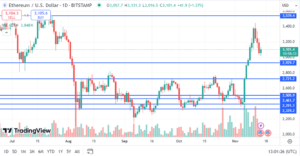Highlights:
- Ethereum is yet to break through the critical $3539.4 resistance
- A rally through the $3539.4 resistance could see Ether test $4k soon
- Institutional demand strengthens Ethereum’s upward momentum
Ethereum has declined slightly today. At the time of going to press, Ethereum was down by 2.29% to trade at its current price of $3113.06. Despite this minor correction, Ethereum’s overall momentum is pretty much to the upside.
Technical Analysis – Ethereum Price Could Test $4K After Breaking the $3539.4 Resistance
Ethereum is still stuck in a range between the $$3539.4 resistance and $2929.7 support. However, bulls are taking control, driven by the bullish sentiment across the market. If bulls sustain momentum and push Ethereum through the $3539.4 resistance, then a rally to $4000 could follow.

On the other hand, if bears take control and push Ethereum to the $2929.7 support, a correction to $2500 could follow. Of these scenarios, there is a higher likelihood of Ether rallying to $4k in the short term. There are several factors that support such price action for Ethereum in the short term. These include more institutional interest in Ethereum in the short term, and Ethereum’s strong fundamentals.
Franklin Templeton Expands $410M Money Market Fund to Ethereum Blockchain
Franklin Templeton, a mutual fund company, has made one of the crucial integration steps in the world of blockchain. It has allowed its OnChain U.S. Government Money Market Fund (FOBXX) to be traded on Ethereum. This strengthens Ethereum’s position as the leading platform for tokenized assets. Ethereum currently has $1.6 billion worth of tokenized assets being transacted, and the numbers are growing.
Ethereum’s growing importance in the tokenized asset space is mainly due to its neutrality, and decentralization. Such characteristics have made Ethereum a favorite among domestic tokenized treasury issuers in the market, where competition with Stellar and Solana has been quite strong.
Ethereum ETFs Attract $650 Million in Under a Week
Ethereum ETFs are also experiencing a resurgence after months of outflows. Over the last five days, Ethereum exchange-traded funds (ETFs) net inflows increased significantly reaching $650 million. This achievement demonstrates the increased level of interest in Ethereum as an alternative investment, especially among institutional investors.
The US Ethereum ETFs as a group have finally achieved net inflows since launch! pic.twitter.com/pSS6848IXQ
— Alistair Milne (@alistairmilne) November 14, 2024
Inflows reached a peak of $295 million on November 11th, followed by $135.9 million on the 12th. The growing net flows confirm the growing importance of Ethereum within the context of digital finance. Matt Hougan, the CIO of Bitwise, noted on social media that even if the market may be pessimistic towards ETH ETFs ‘ETH ETF flows are going to surprise people in 2025.
There is growing institutional demand for ETH exposure, which speaks volumes about ETH. Such developments show an increasing appetite for Ethereum by asset managers through ETFs. As demand picks up pace, the question of Ether’s relevance in the crypto universe has arguably never been clearer.
Ethereum Decentralized Nature: A Big Advantage for Price
Ethereum’s core metrics are also an important factor in its potential price rally. Recently, Vitalik Buterin, Ethereum’s co-founder weighed in on the debate between Solana and Ethereum. In his interview, Buterin went on to point out the fact that operating a Solana node is a more technical process than operating an Ethereum node. He also pointed out that Solana has a wide reliance on the Solana Foundation for development purposes.
As Buterin noted, Solana has an emphasis on high-end applications such as Decentralized Physical Infrastructure Networks (DePIN) that are tailored for telecom as well as hardware firms. These applications, however, are not decentralized but rather focused on speed of execution. This is a stark contrast to the ethos of Ethereum, which aims for long-term ideals of decentralization, neutrality, and security.
Buterin explained that the idea of scalability for Ethereum is based on Layer 2 scaling solutions such as Arbitrum and Base. These help to retain the security and decentralization of the Layer 1 whilst allowing for a larger transaction volume through Layer 2. All this makes Ethereum a superior chain, one that investors will start to appreciate as the price goes up.





